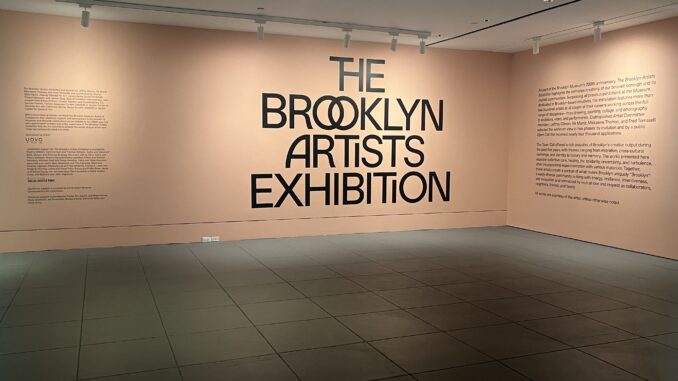
By Jaida Dent
To kick off the celebrations of their 200th anniversary, the Brooklyn Museum presented a collection encompassing artists who have maintained studios in the borough within the last five years. The Brooklyn Artists Exhibition features over 200 artists, in theme with the anniversary, and the works span a range of mediums including paintings, drawings, videos, photography, and sculptures.
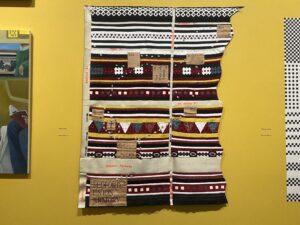
The origins of the Brooklyn Museum date back to 1823, when it was originally known as the “Brooklyn Apprentices’ Library” and later became the “Brooklyn Institute of Art and Sciences,” according to the History of the Brooklyn Museum Building. The museum was an extension of the Institute until the 1970s, when the museum would become independent and known as “The Brooklyn Museum.”
The final 216 artists in the collection were selected either by invitation from the Distinguished Artist Committee or through an “Open Call,” a process by which artists were able to submit their pieces to the museum to be a part of the exhibit. The only requirement was that the artist needed to have lived or maintained a studio in Brooklyn within the last five years. Through the Open Call, over 4,000 pieces were submitted.
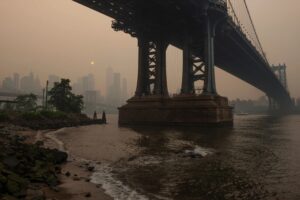
The pieces are connected as all the artists have spent time working in Brooklyn, which contributes to the creativity the borough holds. The exhibit sits in the Great Hall on the first floor, with art across the north and south entrances, along with seven galleries and a video room for an intimate viewing of some video projects.
The exhibition captured Brooklyn through the lens of the artists over the last couple of years. Tracie Dawn Williams’ work, “The collective malaise of an uncertain future,” depicts the Manhattan Bridge on June 7, 2023, the day New York City was covered in smoke due to Canada’s wildfires. The photo serves as a commentary on the unknown when it comes to the outcomes of climate change. In the description of the piece on the Bloomberg Connects Guide, Williams said, “As the temperature of the planet increases every year, so does our collective malaise of an uncertain future.”
Sophia Karwowski’s painting, “Smoke Shop,” captures Brooklyn through a city staple: the local bodega. Karwowski’s painting employs the bright colors and signage indicative of any bodega. The painting visualizes the invisible thread that connects each neighborhood across the borough, which is the homely and welcoming feeling of the local bodega.
Some pieces in the exhibition serve as a means to call for change and voice the untold stories and injustices that Brooklyn and New York City residents face.
Emilie Lemakis’ “Sampler: Collection of Metropolitan Museum of Art Security Guard Wage Pins” (February 2022) utilizes recycled uniforms of security guards from the Metropolitan Museum of Art (MET) and buttons that feature the tenure of the worker and their salary. Lemakis began wearing the button in 2022 and urged her coworkers to do the same as a means to create an open dialogue about the wages they were earning as the New York’s Pay Transparency Law began to take effect. The law requires businesses and workplaces with four or more employees to show the position salaries in job postings.
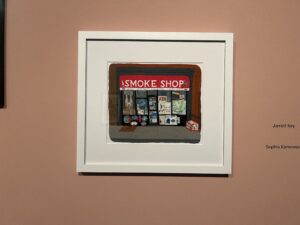
Karen Cunningham’s zine, “The Invisibles, Sanctuary City,” depicts the migrant crisis in New York City along with the issue of homelessness. The zine makes the issue clear in the face of New Yorkers, as the lives of migrants and unhoused individuals become invisible to them.
“This zine is not a comic book but a graphic commentary that asks the viewer to contemplate if living in a city amid the disenfranchised represents an acceptable inconvenience of urban life. Vulnerable populations are at risk of becoming invisible as much as privilege is invisible to those that have it,” said Cunningham in the Bloomberg Connects Guide.
Ronen Gamil’s tapestry, “The Best is Yet to Come,” combines his Yemeni heritage and the effects of racial capitalization in Crown Heights, Brooklyn. The four-layer tapestry depicts a portion of Bedford Avenue and cross streets like Eastern Parkway and Park Place. The piece touches on the state of Crown Heights and how factors like policing and the real estate market can change the neighborhood, such as those susceptible to gentrification.
“The title ‘The Best is Yet to Come’ evokes the orthodox urban planning dictum of ‘the highest and best use’ of land, and expresses concern about the future of Crown Heights and the housing market throughout NYC,” Gamil said in the Bloomberg Connects Guide.
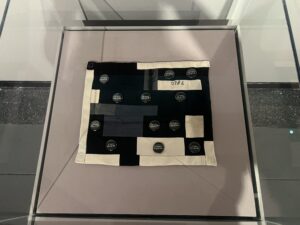
The collection captures and honors the spirit of the Brooklyn Museum through the eyes of the selected artists. Each story is both true to the background and experiences of the artist and their lived experiences in Brooklyn. As the introduction of the exhibition states, “The Brooklyn Artists Exhibition highlights the immense creativity of our beloved borough and its myriad communities.”
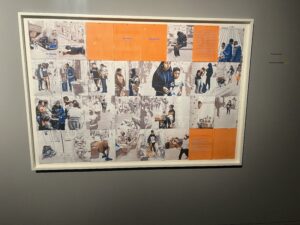
The exhibition is on view until Jan. 26, 2025 at the Brooklyn Museum.
